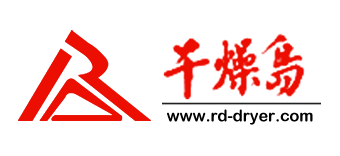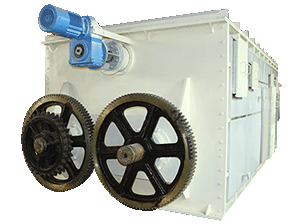Hollow paddle dryer is a horizontal agitating dryer based on heat conduction. Because the inner hollow agitating blade is shaped like a paddle, it is called a Hollow paddle dryer. The paddle dryer has been developed abroad for many years. This type of machine has developed two-axis and four-axis structures and multiple specifications in foreign countries. The paddle dryer was first developed by Germany. After that, the technology was introduced in Japan and improved. Two-axis and four-axis structures and more than ten specifications were developed. Since the heat required for drying the device is indirectly heated by heat conduction, the drying process requires only a small amount of gas to carry away the moisture, which greatly reduces the loss of heat that is carried away by the gas and improves the utilization of heat. Rate, strength drying Hollow paddle dryer is an energy-saving drying device. It can indirectly heat or cool the paste, granule, powder, and slurry materials, and can complete unit operations such as drying, cooling, heating, sterilization, reaction, and low-temperature calcination.
Hollow paddle dryer is widely used in activated sludge, sewage sludge, petrochemical sludge, paper sludge, printing and dyeing sludge, tannery sludge, electroplating sludge, municipal sewage sludge, oil sludge, chemical sludge , electro-ceramic sludge, river channel sediment silt, construction piling sludge, steel-making sludge, industrial metal pickling sludge, coal washing plant clean coal sludge, washed kaolin sludge, ceramics, marble polishing sludge, electronics factory line Sewage sludge, food plant activated sludge, mine beneficiation tailings, paper tailings/tail slag, leather/fur sludge, Chinese herbal medicine extract tailings, biological fermentation bacteria, and other high-humidity materials such as various sludges and various distiller’s grains .
First, the Hollow paddle dryer operating environment requirements
1. Check whether all parts of Hollow paddle dryer are installed properly. Does the lubricating oil added by the reducer meet the requirements of the reducer? Turn the motor fan impeller to check whether the blade shaft and the wall of the tube are not rubbed, the inlet is unblocked, and the inlet is clear. The material port is closed, etc.
2. Cover the motor impeller hood and start the motor to run dry. The blade rotation must meet the specified requirements. The blade runs without any abnormality, vibration and noise. During the gap operation, the feeding amount is limited to the submerged blade of the material, and the material valve is discharged after the specified time is reached.
3. The inlet valve and the condensate drain valve must be slowly opened under the rotation of the blade shaft. The steam should be slowly introduced into the jacket and the blade shaft for a period of 30 minutes or more. The pressure reducing valve and the safety valve must not be adjusted. Exceeding the rated pressure. The wet material can be evenly fed into the dryer under the condition that the steam pressure meets the specified requirements and the equipment is operating normally.
4. When the hollow paddle dryer is working, it is strictly forbidden to entrain the blocky hard material in the wet material to prevent the blocky hard object from getting stuck between the blade and the cylinder, damaging the blade or the cylinder, causing damage to the equipment. . During continuous operation, the amount of charge is controlled so that the host current does not exceed 70% of the rated current.
Second, the Hollow paddle dryer operation steps
1. Drain the condensate from the steam line and close the shutoff valve.
2. Turn on the air switch of the electric control cabinet (the corresponding display shows red light), and start the circulating fan of each heating chamber.
3. When the temperature in the drying chamber reaches 145 °C, set the switch of the speed regulating motor controller to the “on” position, then turn the speed control knob clockwise to make the pointer to the desired position. At the same time, adjust the tightness of the conveyor chain and start feeding the dryer.
4. Open the steam supply shut-off valve and heat the drying chamber. When the steam working pressure is 0.4~1.0Mpa, the excellent performance of the machine can be fully utilized.
5. Control the humidity in the drying chamber by adjusting the angle of the inlet and exhaust dampers to achieve the best dry condition of the material.
6. When the last batch of material leaves the dryer, the steam shut-off valve can be closed, and the fans will be turned off later (the corresponding green light is off).
7. When the last batch of material leaves the Hollow paddle dryer, turn off the main drive (the corresponding display green light is off), then turn the speed control knob counterclockwise to the zero position, and the controller switch is placed in the “off” position (the corresponding display is red) ).
Third, Hollow paddle dryer operation precautions
1. Check the gas source triple piece before starting the machine to drain the water and ensure sufficient oil level.
2. Do not allow overpressure or overload operation.
3. For different materials, care should be taken to control the feed rate to ensure smooth operation. In particular, it is not allowed to add large quantities of materials. Large pieces of metal or hard blocks such as stones are not allowed in the material to avoid damage to the equipment.
3. The material speed can be adjusted by using the discharge adjustment mechanism. After the commissioning personnel adjust, the equipment user must not change the position at will.
4. Observe whether the current is within the rated value of the motor. Otherwise, find the cause and solve it immediately.
5. The inlet valve and the condensate drain valve must be slowly opened under the rotation of the blade shaft. The steam should be slowly introduced into the jacket and the blade shaft. The time is controlled for more than 30 minutes. The pressure reducing valve and the safety valve must not be adjusted. Exceeding the rated pressure. The wet material can be evenly fed into the dryer under the condition that the steam pressure meets the specified requirements and the equipment is operating normally.
6. Open the sight glass cover on the bearing body and observe if there is any leak in the seals.
7. The gear meshing parts and chain should be greased in time, and pay attention to dust and cover dust cover.
8. After using the equipment for one week, drain the lubricating oil in the reducer and replace the new oil of the same model.
9. When parking, try to drain the materials in the machine, stop the steam inlet and drain the condensate, close all the valves, and stop the rotation of the blade shaft after all the equipment is cooled to room temperature (to prevent the blade shaft from bending and deforming) ).
10. When the gap is operated, the feeding amount is limited to the submerged blade of the material. After the specified time is reached, the material valve is discharged.
11. During continuous operation, control the amount of material to be fed so that the maximum current of the main unit does not exceed 70% of the rated current.
12. It is strictly forbidden to entrain the blocky hard material in the wet material to prevent the blocky hard object from getting stuck between the blade and the cylinder body, damaging the blade or the cylinder body, causing the equipment to be damaged and leaking.
13. The temperature of the intended bearing body should not be higher than 70 degrees Celsius, and high-quality grease can be added at the right time. The amount of cooling water to be adjusted for the bearing body and the shaft seal packing with a cooling device.
Although the Hollow paddle dryer is a relatively efficient and energy-saving dryer, if it is not noticed during the operation, it will cause some equipment failures and operational errors. Over time, it will affect the service life of the Hollow paddle dryer. It is not enough to ensure that the service life of the paddle dryer is based on the correct operating procedures. Some daily maintenance techniques are needed to achieve the desired results, such as the following:
1. After the production is completed, if it is not used for a long time, it should be cleaned, especially the door seals are cleaned to prevent aging. Close the door tightly, do not tell the door locking device is too tight to prevent deformation, and cut off the power and water.
2. If it is not used for a long time, it should be cleaned regularly. Please do not use liquid with acid and alkali strength to clean it. Clean it with water. After cleaning, pay attention to dry the water.
3. For the water ring vacuum pump, it is necessary to replace the circulating water every day. If it is to be used for a long time, it must be exhausted after the use of the vacuum pump, and the vacuum pump should be pumped every day when the temperature is below zero in winter. The body water should be drained. Before the next use, please pay attention to whether the vacuum pump is rusted. If the rust is dead, remove the vacuum pump motor back cover and screw the motor shaft with a tool.
4. For the rotary vane vacuum pump, the vacuum pump oil should be replaced regularly, once or twice a month. If it is to be used for a long time, the vacuum pump oil must be drained after one use, and the new vacuum pump oil should be injected before the next use.
5. the common parts expired need to be replaced, such as vacuum table damage, need to replace the new vacuum table, the seal is aging due to age, should be purchased from the manufacturer, each valve will cause the PTFE seal in the valve after a long time Wear and tear, so that the vacuum can not be pumped to a reasonable value, the new air valve should be replaced immediately.
6. If the equipment fails during normal use, it should immediately respond to the manufacturer and should not be disassembled by itself to avoid serious damage.



